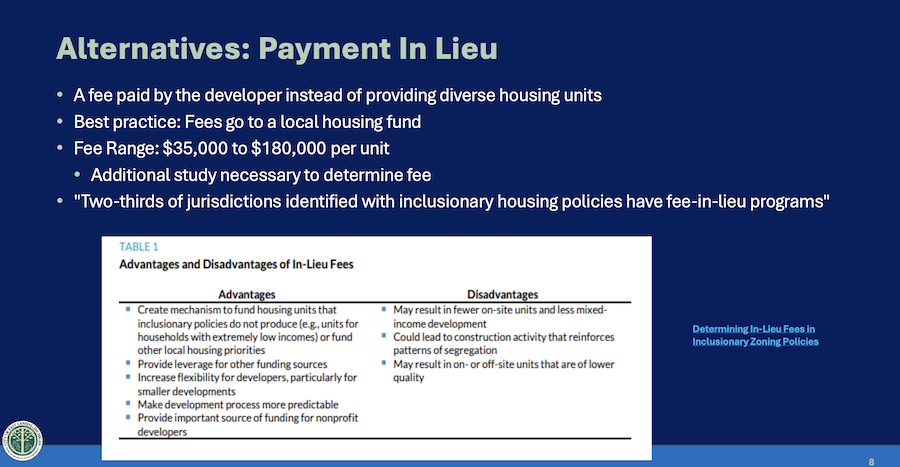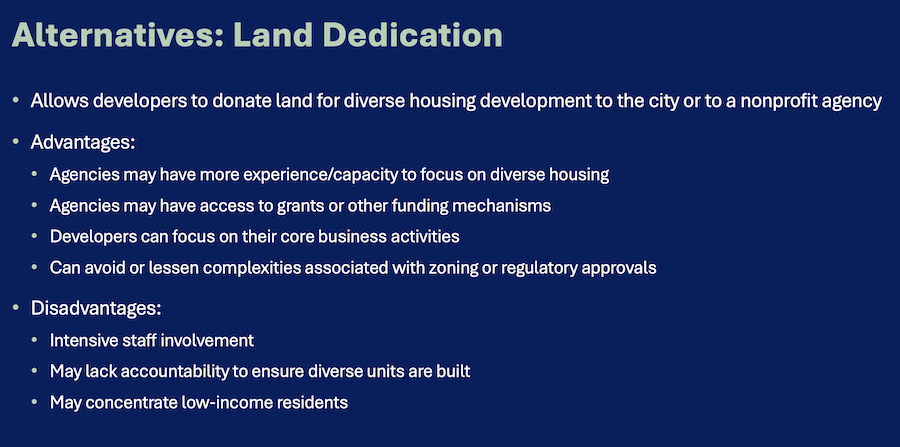East Lansing Explores New Tools to Spur Downtown Housing Diversity as Developers Push Back on 25% Requirement
East Lansing Principal Planner Landon Bartley broke down a series of ordinance changes or incentives the city could deploy to diversify its housing stock, especially downtown, at the Sept. 16 discussion-only City Council meeting.
Currently, the city requires that 25% of units in new projects built downtown be affordable to low-to-moderate income renters, owner occupied, dedicated to people 55 and older or serve some other purpose to diversify the area’s housing stock.
However, since the city adopted the 25% diverse housing ordinance in 2016, just 91 units have been added to the downtown that meet the requirements, the units at Newman Lofts dedicated to people 55 and older.
Bartley did not suggest getting rid of the 25% requirement, rather he explained incentives the city can offer to help developers achieve the requirement, or ordinance amendments that can be made that would lower the requirement for some projects or give developers alternate routes to helping the city meet its housing goals.
The discussion around downtown housing arises as the owners of the Student Book Store are pitching a large housing project, “The Howard,” to be built where the book store stands now. However, the business owners have said the city’s 25% diverse housing requirement makes the project unfeasible.
During a short discussion after Bartley’s presentation, one council member said he has been hearing from more developers looking to build in East Lansing, and another said he thinks the city should explore expanding its downtown.
The possible changes presented by Bartley on Sept. 16 have been discussed at recent Planning Commission meetings. While council did not vote on any of the suggestions, some of the ideas may return at a future meeting.
There is no perfect solution to diversify the downtown housing stock. During his presentation, Bartley explained both benefits and drawbacks associated with each incentive and ordinance change.
Density or height bonuses
This incentive would allow developers to construct projects that exceed the downtown district’s eight-story height limit or add more units if they include an element of diverse housing.
This incentive would make the development process more predictable for businesses and may bring bring diverse housing to areas that it would otherwise not be feasible, Bartley said.
At the same time, the incentive may not be enough of an encouragement to developers on its own and would likely need to be coupled with another mechanism to effectively usher in developments. It would also require the city allocate additional staff time to working with developers, Bartley said.
Additional or longer tax abatements
This incentive would reduce or remove local taxes on housing developments downtown for some time period.

Tax abatements are often necessary to add affordable housing in high cost environments, Bartley said.
An abatement would limit revenue the city will receive from a project, however, Bartley said. This could be a challenging balance to strike as the city continues to face financial issues.
Weigh different types of housing differently
Under this provision, the 25% rule would be amended to require fewer units of housing types the city deems to be more desirable, Bartley explained. He added that City Manager Robert Belleman recommends weighing owner occupied units the heaviest.
“Essentially, if you say ‘Yes, you only need to provide 20% instead of 25%,’ that it would make it easier for the developer to meet the requirement and you’d see more of that unit type be produced,” Bartley said.
Amending the ordinance to weigh types of housing differently could make it easier for developers to add certain types of housing and could help the city quickly address a priority, Bartley said.
However, this change could also result in only the type of housing that is weighed the heaviest being brought to the city, Bartley said.
Install a payment in lieu system
If the city were to install a payment in lieu system, developers who are unable to meet the diverse housing requirement can instead pay into a fund, ideally a housing fund, which the city can then use to carry out its goals, Bartley said.

“What we’ve seen as a best practice from other communities is that there is a local housing fund, often administered in fact by a nonprofit, that receives the funds and then uses the funds to produce the units themselves,” Bartley said. “In other models we’ve seen that the fund receives money from developers and then uses that to incentivize, through financial incentives, affordable housing projects or other housing types.”
Most communities that have diverse housing requirements for new developments have a payment in lieu option, Bartley added.
The developers who have proposed The Howard have said the city should implement a payment in lieu system, initially offering to pay $5,000 per unit. Bartley said the Planning Commission found this is not enough and a payment in lieu program should charge between $35,000 and $180,000 per unit.
Bartley acknowledged that this payment would be a “heavy lift” for many developers, but said it would give the city significant funding to carry out its housing goals. He added that payments on the higher end of the scale are often paired with a tax abatement.
Off-site units
This amendment would allow developers to add units to meet the diverse housing requirement at a separate location that may not be in the downtown district.
Additionally, Bartley said this amendment could allow developers to transfer diverse housing units to developments in different zone districts. This may encourage developers to add housing above retail locations in business districts, for example, Bartley said.
Bartley added that he does not recommend allowing developers to build these units in residential zones.
This would open the city up to adding diverse housing in new locations, Bartley said.
At the same time, it could concentrate affordable units in lower income areas of the city and without specific design requirements, could result in low quality units being built, Bartley said.
Count units with tenant using Housing Choice Voucher towards 25% rule
The Housing Choice Voucher program, which is also commonly referred to as the Section 8 Voucher program, is the federal government’s major initiative to house people with serious financial challenges. The vouchers are distributed to very low income people and families and cover all or some of their rent.
Bartley said that if the city counts people using Housing Choice Vouchers towards the diverse housing requirement, it could lead to property managers encouraging these voucher holders to live in their buildings, giving them access to housing that would otherwise be difficult to obtain.
However, this program may be difficult to manage because vouchers are tied to individual tenants, not units themselves. The Housing Choice Voucher program is also not locally controlled, Bartley said.
Land dedications
This ordinance amendment would allow developers to donate land they have elsewhere in East Lansing to the city or a nonprofit organization to be used as the site of a new diverse housing project. The developer may also keep that property, but restrict its use to be diverse housing, Bartley said.

Bartley said it’s not clear how a land dedication would translate for a developer to meet the diverse housing requirement, but this is a strategy other cities have used.
A land dedication could transfer the responsibility of bringing affordable housing to agencies with more experience and open up more outside funding opportunities for developers, Bartley said.
This amendment may also concentrate low income renters to specific areas, could be difficult to enforce and would require extensive staff involvement, Bartley said.
The land dedication option is similar to the deal the city struck with developers before they constructed The Abbot, Bartley said. Under that agreement, developers were to bring a separate building mostly made up of affordable rental units. While The Abbot opened in 2021, the future of the affordable housing project is still uncertain.
Dedication of existing units
This ordinance amendment would allow developers to use their existing units to meet the diverse housing requirement, including buildings outside of the downtown district.
“Maybe they’re currently market rate and you can say ‘I will change these units from market rate to a diverse housing type,’” Bartley said.
This option would be more environmentally sustainable because “the greenest building is the one already built,” Bartley said. It can also be more cost-effective and can bring diverse housing faster because it doesn’t require a new building.
This amendment may require developers to undergo significant renovations to their properties and could concentrate low income renters, Bartley said.
Expedited approvals process
This ordinance amendment would move diverse housing projects to the front of the line in the project approval process, Bartley said.
Faster approval can translate to cost-savings for developers, especially if there is a long “development pipeline,” Bartley said.
Bartley noted that this incentive usually works better in larger cities that have more developments in the queue and that East Lansing does not have many developments awaiting approval right now.
Council does not take action on proposals
The Sept. 16 meeting was discussion-only, so council was not expected to take action. Following Bartley’s presentation, Mayor George Brookover asked council members to direct questions to Bartley and Belleman, and proposed the body return to the topic within 30 days.
During the short conversation after Bartley’s presentation, Councilmember Mark Meadows said he does not think the city’s diverse housing ordinance is preventing developers from constructing projects downtown, rather he thinks the city is still experiencing the consequences of the COVID-19 pandemic.
These consequences may be subsiding. Meadows said he has been hearing from more developers who want to build in East Lansing.
“I think we’re starting to get back to the development stage that we were in the past,” he said. “I know I’ve been contacted by a lot of developers.”
Still, Meadows said he thinks some of the proposed changes may be warranted.
Councilmember Erik Altmann said he thinks the city should explore options to “expand the downtown.” He said the downtown is long and narrow, and there are two or three blocks of rental homes between the downtown and owner occupied neighborhoods. He thinks expanding the downtown into this area could be beneficial.
“That could really change things a lot, given the constraints, we’re dealing with the very high land values and so forth,” he said.
This story was updated to remove a duplicate paragraph.

